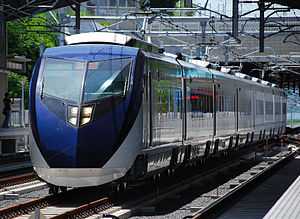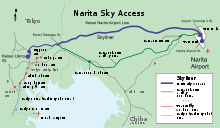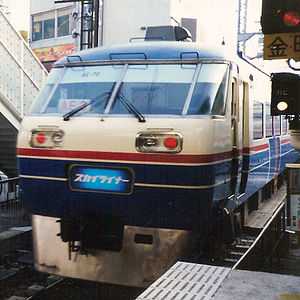Skyliner
| Skyliner | |
|---|---|
 Keisei AE series EMU on a Skyliner service, July 2010 | |
| Overview | |
| Service type | Limited express |
| Locale | Kanto region, Japan |
| First service | 1972 |
| Current operator(s) | Keisei Electric Railway |
| Route | |
| Start | Keisei Ueno |
| End | Narita Airport |
| Average journey time | 36 minutes (fastest) |
| Line used | Narita Sky Access |
| On-board services | |
| Class(es) | Monoclass |
| Seating arrangements | Forward facing 2+2 |
| Technical | |
| Rolling stock | Keisei AE series EMUs |
| Track gauge | 1,435 mm (4 ft 8 1⁄2 in) |
| Electrification | 1,500 V DC overhead |
| Operating speed | 160 km/h (100 mph) |
The Skyliner (スカイライナー sukairainā) is a limited-express airport train service between Tokyo and Narita Airport in Japan. It is operated by Keisei Electric Railway and runs on the Narita Sky Access route.
Service

The Skyliner service operates between Keisei Ueno Station and Narita Airport Station, with stops at Nippori Station and Airport Terminal 2 Station.
The one-way ride between Nippori and Narita Airport takes about 36 minutes and costs ¥2,400.
The main competition for the Skyliner is JR East's Narita Express.
Station stops
- Keisei Ueno
- Nippori
- Narita Airport Terminal 2
- Narita Airport
History
1972-2010

The Skyliner's predecessor was the Kaiungō express service, which began operation non-stop from Keisei Ueno to Keisei Narita on May 1, 1952, 26 years before the opening of Narita Airport. Seat reservations were mandatory.
The Kaiungō Express service was operated by 1600 series trains from 1953 to 1967. Although the first trains were small, with only two cars, they had reclining seats and televisions, making them luxurious trains for their time. The trains were lengthened to three cars in 1957 (although only one of those cars was an actual Type 1600 car). In 1967, the 1600 series trains were replaced by 3150 and 3200 series trains, fitted with semi-transverse seating in order to comply with subway specifications.
In 1972, new AE series trains began operation as the Skyliner, while the Kaiungō became the main train running during afternoons and holidays. The Kaiungō service was taken over by AE series trains on December 30, 1973, and the Skyliner became a nonstop Ueno-Narita service. Although the Skyliner's name was chosen, it wasn't announced soon enough and thus the first trains were shipped with the inscription "Express".
In the final months preceding Narita Airport's opening, there were a number of violent protests at the airport. One arson attack caused an AE series train in a yard to be put out of service on May 5, 1978.
Finally, on May 21, 1978, upon the opening of New Tokyo International Airport, the Skyliner began nonstop runs from Keisei Ueno to Narita Airport Station. At the time, Narita Airport Station was located far from the passenger terminal (at the present-day location of Higashi-Narita Station), and passengers on the Skyliner had to get off and take a bus from the station to the airport. This inconvenience caused many passengers to use direct city-to-terminal limousine buses rather than the Skyliner.
Starting on September 1, 1979, the Skyliner began stopping at Keisei Narita Station once a day during the afternoon. This commuter-oriented service was expanded to become the Evening Liner service on December 1, 1984, and the Morning Liner was added on October 19, 1985. Nippori was added as a stop on the new commuter services, and in 1988, all Skyliner services began making stops at Nippori Station.
Growing criticism of Narita ground transportation in the late 1980s led the Ministry of Transport to open up underground platforms and track initially intended for the Narita Shinkansen (a high-speed rail link between the city and the airport that was never built) for service by regular local and express trains. On March 19, 1991, the new Narita Airport Station opened directly underneath Terminal 1. Both the Skyliner and its new competitor, JR East's Narita Express, began service to the new station. On December 3, 1992, services began to Airport Terminal 2.

Eight-car AE100 series trains were introduced in 1990. These trains were designed with emergency exits at each end, under the assumption that the trains would eventually be used for limited express service between Narita Airport and Haneda Airport: the Toei Asakusa Line has no emergency walkways along its sides, so it was necessary to allow evacuation from the ends of the train. Following the introduction of the AE100s, the seven six-car AE series trains were rearranged to form five eight-car trains. In June 1993, these older AE series trains were withdrawn from service.
From December 10, 2006, most Skyliner services began stopping at Keisei Funabashi Station.
2010: Narita Sky Access opening
From July 17, 2010, the Skyliner services were transferred from the Keisei Main Line to the Narita Sky Access route, with the introduction of new AE series EMUs. New City Liner services using the older AE100 series trains replaced the former Skyliner on the Keisei Main Line.
The new Skyliner service allows a transfer from Central Tokyo to Narita Airport in 36 minutes, 15 minutes faster than the old route via the Keisei Main Line, making it the fastest train option connecting Narita Airport with Central Tokyo.
March 2011 Great East Japan Earthquake
Some Sky Liner services were suspended following the Great East Japan Earthquake of 11 March 2011 and subsequent energy restrictions implemented in the Tokyo area. Full service was however restored from 10 September 2011, following the lifting of energy restrictions.[1]
References
- ↑ "電力使用制限解除に伴う京成線の運行等について" [Keisei Line Operations following lifting of power restrictions]. News release (in Japanese). Japan: Keisei Electric Railway. September 2011. Retrieved 20 September 2012.